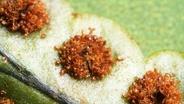The undersides of ferns have many looks.
But all these intricate structures do the same thing.
They hold – and then launch – the fern’s spores.
Spores are the main way ferns make more ferns, but they’re not the eggs or sperm.
Those come later.
Since before the dinosaurs roamed … and plants grew sex organs called flowers … ferns have been “doing it” through flying spores and swimming sperm.
When the spores mature, a fern leaf comes alive.
Look how things are moving under there.
Each of these clusters is called a sorus.
And every worm-like thingy is a sporangium full of spores.
The sporangium has an outer ring filled with water.
When it’s warm outside, that water starts to evaporate.
The ring shrinks, making the sporangium crack open.
The ring bends farther and farther back.
The sporangium jerks forward … and catapults the spores out.
A single fern launches millions of spores.
Each one grows into a gametophyte.
But these pea-sized plants aren’t baby ferns.
Where their fern parent was asexual, the gametophytes make eggs and sperm in specialized organs.
Yep, fern sperm.
It’s a thing.
Look at these little curlicues.
When the rains come, sperm swim away from the gametophyte that made them – a tiny puddle will do.
They follow a trail of pheromones to find eggs stored in nearby gametophytes.
When sperm meets egg, ta-da!
A fern sprouts right out of its gametophyte mother, which it feeds on.
Now, this is a baby fern.
Finally.
Awww.
Ferns don’t need to wait around for some insect to help them with pollination.
They can go it alone, as long as there’s water.
So, next time you go on a walk through a damp forest,















